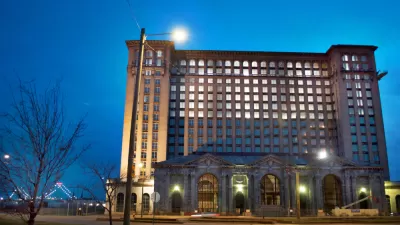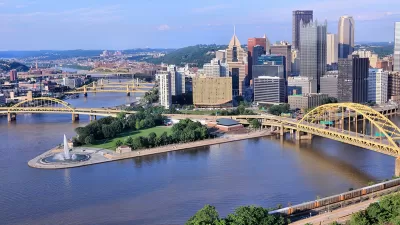Buffalo made its fortune in long-gone heavy industries such as steel. Now a new industrial revolution—in renewable energy—is bringing new life to the coldest, northernmost city of the American Rust Belt.

Now, things are turning around. Aided in part by a $1 billion redevelopment assistance plan from the state, the Buffalo region now has a healthy 5.3 percent unemployment rate. Some of those jobs are at high-tech companies, including Yahoo, that are capitalizing on the region's cheap energy, powered by Niagra Falls, which the defunct factories no longer use. Cheap real estate doesn't hurt either. Equally importantly, an emerging industrial economy is taking the place of the old one, building turbines and windmills near places that used to make girders and rails. There's a green energy complex, and the solar power company SolarCity has built a factory.
"Under the [redevelopment] plan, developed after a study from the Brookings Institution along with local community and business organizations, the state is trying to seed a cluster economy, Gov. Andrew Cuomo said, targeting several areas, including advanced manufacturing, health and life sciences and tourism. Seeing the opportunities for renewable energy came out of that process."
While the region has an extensive industrial infrastructure, it also has a robust social infrastructure, which has stuck around since Buffalo's heyday.
"Despite the long decline, much of that infrastructure remains — including transmission and rail lines, professional schools and fine art museums. All of that, along with generous government subsidies, is proving attractive to new industries like clean energy and advanced manufacturing."
The city is even attracting hipsters.
"Nowhere is the transformation more evident than in Larkinville, a collection of 19th-century buildings once clustered around the Larkin Soap Company that has become a work, entertainment and dining destination inspired by similar districts like Dumbo and Williamsburg, Brooklyn."
FULL STORY: The Wind and Sun Are Bringing the Shine Back to Buffalo

Alabama: Trump Terminates Settlements for Black Communities Harmed By Raw Sewage
Trump deemed the landmark civil rights agreement “illegal DEI and environmental justice policy.”

Planetizen Federal Action Tracker
A weekly monitor of how Trump’s orders and actions are impacting planners and planning in America.

The 120 Year Old Tiny Home Villages That Sheltered San Francisco’s Earthquake Refugees
More than a century ago, San Francisco mobilized to house thousands of residents displaced by the 1906 earthquake. Could their strategy offer a model for the present?

In Both Crashes and Crime, Public Transportation is Far Safer than Driving
Contrary to popular assumptions, public transportation has far lower crash and crime rates than automobile travel. For safer communities, improve and encourage transit travel.

Report: Zoning Reforms Should Complement Nashville’s Ambitious Transit Plan
Without reform, restrictive zoning codes will limit the impact of the city’s planned transit expansion and could exclude some of the residents who depend on transit the most.

Judge Orders Release of Frozen IRA, IIJA Funding
The decision is a victory for environmental groups who charged that freezing funds for critical infrastructure and disaster response programs caused “real and irreparable harm” to communities.
Urban Design for Planners 1: Software Tools
This six-course series explores essential urban design concepts using open source software and equips planners with the tools they need to participate fully in the urban design process.
Planning for Universal Design
Learn the tools for implementing Universal Design in planning regulations.
Clanton & Associates, Inc.
Jessamine County Fiscal Court
Institute for Housing and Urban Development Studies (IHS)
City of Grandview
Harvard GSD Executive Education
Toledo-Lucas County Plan Commissions
Salt Lake City
NYU Wagner Graduate School of Public Service





























